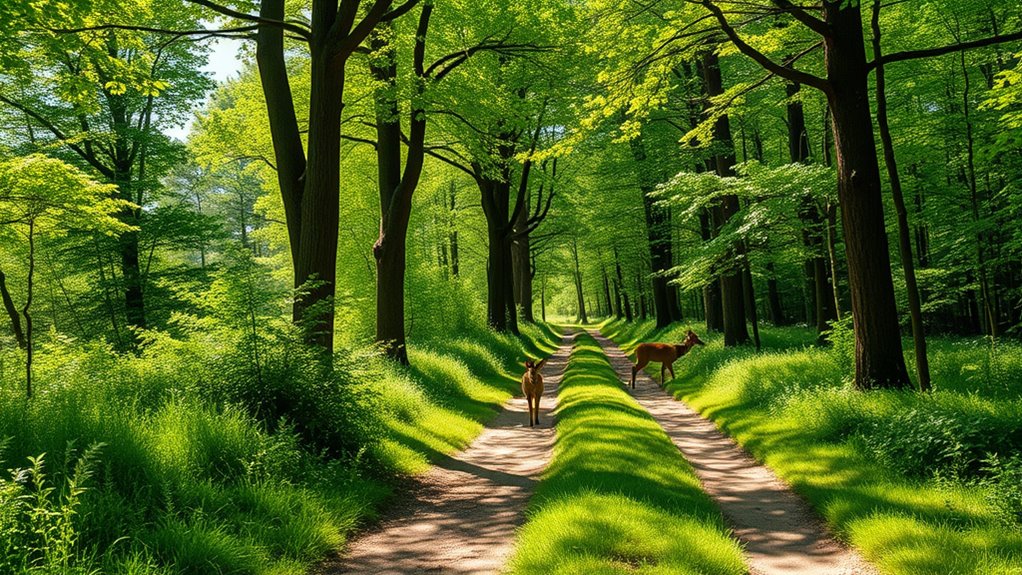Wildlife corridors are essential pathways that connect fragmented habitats, allowing animals to travel safely between areas for migration, breeding, and access to resources. By respecting these animal highways, you help reduce human-wildlife conflicts and support ecological health. Urban expansion and development often threaten these pathways, so understanding their importance encourages responsible action and planning. Staying informed about how you can protect and preserve these corridors will guide you toward making a meaningful difference for wildlife conservation.
Key Takeaways
- Wildlife corridors are vital for connecting fragmented habitats and supporting biodiversity in urbanized landscapes.
- Respectting animal highways reduces human-wildlife conflicts and minimizes road accidents involving wildlife.
- Incorporating green pathways in urban planning enhances ecological resilience and ensures safe animal migration.
- Recognizing corridor importance aids conservation efforts and promotes sustainable development practices.
- Understanding habitat connectivity is essential for maintaining ecosystem health and securing future biodiversity.

Wildlife corridors are fundamental pathways that connect fragmented habitats, allowing animals to move safely between them. As urban expansion continues to reshape landscapes, natural habitats become increasingly divided by roads, buildings, and other human developments. This habitat fragmentation creates barriers that can trap animals in limited areas, forcing them to navigate dangerous environments or remain isolated, which ultimately threatens their survival. Recognizing the importance of these corridors helps you understand how essential it is to maintain and restore natural pathways that support wildlife movement.
Wildlife corridors connect fragmented habitats, enabling safe animal movement amid increasing urban development threats.
When cities and towns grow outward, they often cut through ecosystems, breaking up once-continuous habitats into smaller patches. This process disrupts migration patterns, breeding grounds, and access to food and water sources. Without safe routes, many species struggle to find new territories, leading to decreased populations and even local extinctions. As someone concerned about conservation, you can see how urban expansion directly impacts biodiversity, making the preservation of wildlife corridors indispensable for maintaining ecological balance.
Understanding the role of wildlife corridors means recognizing that these pathways are not just convenient routes; they are lifelines for animals. They enable species to relocate in response to seasonal changes, find mates, and access resources essential for survival. In areas where habitat fragmentation is most severe, corridors act as bridges that reconnect isolated populations, giving them the chance to thrive rather than dwindle. Your awareness of these dynamics can influence how communities plan developments, encouraging smarter urban designs that incorporate green spaces and migration pathways.
By respecting animal highways, you also help mitigate human-wildlife conflicts. When animals are forced to cross busy roads or navigate through urban areas, accidents and fatalities increase. Wildlife corridors reduce these risks by providing designated crossing points, which are safer and more efficient. Supporting initiatives that prioritize the creation and maintenance of these corridors helps ensure that wildlife can move freely without endangering themselves or disrupting human activities.
In essence, your role in understanding and respecting wildlife corridors is indispensable. As urban areas continue to expand, it’s up to you—whether through advocacy, supporting conservation projects, or simply making informed decisions—to promote the preservation of these vital pathways. They are not just corridors for animals; they are essential threads maintaining the health of entire ecosystems. Protecting them helps sustain biodiversity, supports ecological resilience, and ensures that future generations can enjoy the rich tapestry of life that nature provides. Recognizing the importance of habitat connectivity is crucial for effective conservation efforts and long-term ecological health.
Frequently Asked Questions
How Do Wildlife Corridors Impact Local Communities Economically?
Wildlife corridors positively impact your local community by providing economic benefits, such as attracting eco-tourism and outdoor activities that boost local businesses. They also promote community engagement, encouraging residents to participate in conservation efforts and nature preservation. These corridors help maintain healthy ecosystems, which can reduce costs related to environmental damage. Overall, investing in wildlife corridors fosters a sustainable economy and strengthens community ties, creating a more vibrant and resilient neighborhood.
What Are the Main Challenges in Establishing New Wildlife Corridors?
Establishing new wildlife corridors is like fitting puzzle pieces together, but habitat fragmentation makes it tricky. You face challenges like land acquisition, where convincing landowners to sell or set aside land requires negotiation and incentives. Additionally, balancing economic development and conservation efforts complicates the process. Overcoming these hurdles demands collaboration, patience, and innovative solutions to guarantee animals can safely move across fragmented habitats.
How Can Technology Improve the Effectiveness of Wildlife Corridors?
Technology can markedly boost wildlife corridor effectiveness by deploying sensor networks that monitor animal movements in real-time. You can use GIS mapping to identify key migration routes and habitat changes, helping you plan better corridors. These tools enable proactive management, ensuring corridors stay functional and safe. By integrating sensor data and GIS insights, you’ll create more adaptive, effective wildlife corridors that facilitate animal movement and reduce human-wildlife conflicts.
Are There Legal Regulations Protecting Wildlife Corridors?
About 60% of countries have some legal protections for wildlife corridors, but enforcement varies. You should know that multiple regulatory frameworks exist to safeguard these essential pathways, ensuring animals can move safely between habitats. These laws often include restrictions on land development or construction near corridors. Staying informed about local regulations helps you support efforts to preserve wildlife corridors and maintain ecological balance.
How Do Climate Change Effects Influence Wildlife Corridor Planning?
Climate change impacts how you plan wildlife corridors by emphasizing climate resilience and habitat connectivity. As temperatures rise and weather patterns shift, you need to design corridors that adapt to changing conditions, ensuring animals can move safely between habitats. This means considering future climate scenarios and creating flexible, connected pathways, so wildlife maintains access to essential resources and sustains populations despite environmental changes.
Conclusion
As you walk these corridors, it’s no coincidence that nature’s story unfolds before you. Respecting these animal highways isn’t just about conservation; it’s about honoring the silent journeys that connect us all. When you pause and observe, you realize that every step you take echoes the intricate dance of life. By understanding and protecting these pathways, you become part of a larger, beautiful coincidence—nature’s delicate balance, thriving because of your mindful choices.










